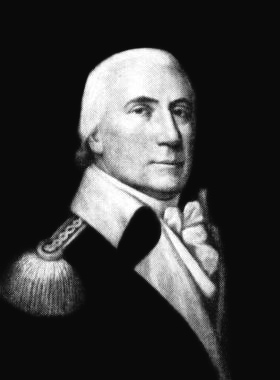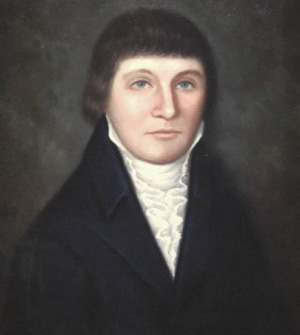
George Walton was a Founding Father of the United States who signed the United States Declaration of Independence while representing Georgia in the Continental Congress. Walton also served briefly as the second chief executive of Georgia in 1779 and was again named governor in 1789–1790. In 1795, he was appointed to the U.S. Senate, to complete the unexpired term of a senator who had resigned.

Alexander Martin was a Founding Father of the United States, framer of the U.S. Constitution, fourth and seventh Governor of North Carolina, and an infantry officer in the American Revolutionary War. In private life, Martin was a lawyer, merchant, planter, and slave owner.

The North Carolina General Assembly of 1777 met in two sessions in New Bern, North Carolina, from April 7 to May 9, 1777, and from November 15 to December 24, 1777. This was the first North Carolina legislature elected after the last provincial congress wrote the first North Carolina Constitution. This assembly elected Richard Caswell as the state's first constitutional governor.
The North Carolina General Assembly of 1779 met in three sessions in three locations in the years 1779 and 1780. The first session was held in Smithfield from May 3 to May 15, 1779; the second session in Halifax, from October 18 to November 10, 1779; the third and final session in New Bern, from January to February, 1780.
Whitmell Hill was an American planter from Martin County, North Carolina and commander of the Martin County Regiment of the North Carolina militia during the American Revolution. He was a delegate for North Carolina to the Continental Congress from 1778 to 1780 and served as Speaker of the North Carolina House of Commons in 1778.

Henry Latimer was an American physician and politician from Newport, Delaware. He was elected to the Continental Congress from Delaware, and was a member of the Federalist Party, who served in the Delaware General Assembly, as U.S. Representative from Delaware, and U.S. Senator from Delaware.

John Milledge was an American politician. He fought in the American Revolution and later served as United States Representative, 26th Governor of Georgia, and United States Senator. Milledge was a founder of Athens, Georgia, and the University of Georgia. From January to May 1809, Milledge served briefly as President pro tempore of the United States Senate.
Waightstill Avery was an early American lawyer and officer in the North Carolina militia during the American Revolution. He is noted for fighting a duel with future U.S. president Andrew Jackson in 1788.

Richard Henderson was an American jurist, land speculator and politician who was best known for attempting to create the Transylvania Colony in frontier Kentucky. Henderson County and its seat Henderson, Kentucky are named for him. He also sold land to an early settlement that went on to become Nashville, Tennessee.
The Supreme Executive Council of the Commonwealth of Pennsylvania was the collective directorial executive branch of the Pennsylvanian state government between 1777 and 1790. It was headed by a president and a vice president. The best-known member of the Council was Benjamin Franklin, who also served as its sixth president.

The president pro tempore of the North Carolina Senate is the highest-ranking officer of one house of the North Carolina General Assembly. The president of the Senate is the Lieutenant Governor of North Carolina, but the president pro tempore actually holds most of the power and presides in the absence of the Lt. Governor. The president pro tempore, a senior member of the party with a majority of seats, appoints senators to committees and also appoints certain members of state boards and commissions. From 1777 to 1868, North Carolina had no Lieutenant Governor, and the highest-ranking officer of the Senate was known as the "Speaker". The Speaker of the Senate was next in line if the office of Governor became vacant. This occurred on two occasions.
The 5th General Assembly of Nova Scotia represented Nova Scotia between May 1770 to 1784, its membership being set in the 1770 Nova Scotia general election.
The 6th General Assembly of Nova Scotia represented Nova Scotia between November 1785 to 1793.
The Edenton District Brigade was an administrative division of the North Carolina militia during the American Revolutionary War (1776–1783). This unit was established by the North Carolina Provincial Congress on May 4, 1776, and disbanded at the end of the war.
The North Carolina General Assembly of 1780-1781 was the fourth elected legislative body of the State of North Carolina. The assembly consisted of a Senate and House of Commons that met in three sessions in at least two locations in the years 1780 and 1781. Each of the existing 50 North Carolina counties were authorized to elect one Senator and two members of the House of Commons. In addition, six districts also elected one House member each. The first two sessions were probably held in New Bern, North Carolina in April and September 1780. The third session met in Halifax from January 27, 1781 – February 13, 1781.

The Fifth North Carolina Provincial Congress was the last of five extra-legal unicameral bodies that met beginning in the summer of 1774. They were modeled after the colonial lower house. These congresses created a government structure, issued bills of credit to pay for the movement, organized an army for defense, wrote a constitution and bill of rights that established the state of North Carolina, and elected their first acting governor in the fifth congress that met in 1776. These congresses paved the way for the first meeting of the North Carolina General Assembly on April 7, 1777 in New Bern, North Carolina. The Fifth Congress met in Halifax from November 12 to December 23, 1776. Richard Caswell served as president, with Cornelius Harnett as vice-president.
The North Carolina General Assembly of April to June 1784 met in New Bern from April 19 to June 3, 1784. The assembly consisted of the 120 members of the North Carolina House of Commons and 50 senators of North Carolina Senate elected by the voters in April 1784. As prescribed by the 1776 Constitution of North Carolina, the General Assembly elected Alexander Martin to continue as Governor of North Carolina. In addition, the assembly elected members of the Council of State.
The North Carolina General Assembly of October 1784 met in New Bern from October 25, 1784 to November 26, 1784. The assembly consisted of the 116 members of the North Carolina House of Commons and 55 senators of North Carolina Senate elected by the voters on August 20, 1784. As prescribed by the 1776 Constitution of North Carolina the General Assembly elected Richard Caswell as Governor of North Carolina and members of the Council of State.
The North Carolina General Assembly of 1785 met in New Bern from November 18, 1785, to December 29, 1785. The assembly consisted of the 114 members of the North Carolina House of Commons and 54 senators of North Carolina Senate elected by the voters on August 19, 1785. During the 1785 session, the legislature created Rockingham County. As prescribed by the 1776 Constitution of North Carolina the General Assembly elected Richard Caswell to continue as Governor of North Carolina and members of the Council of State.
The North Carolina General Assembly of 1862–1864 met in Raleigh from November 17, 1862, to December 22, 1862. Extra sessions were held on January 19, 1863 – February 12, 1863; June 30, 1863 – July 7, 1863; November 23, 1863 – December 14, 1863; and May 17–30, 1864. The assembly consisted of the 120 members of the North Carolina House of Commons from 82 counties and 50 senators representing one or more counties in North Carolina Senate elected by the voters in October 1862. Zebulon Baird Vance was Governor of North Carolina during this assembly. This assembly met during the American Civil War as part of the Confederate States of America. Much of the legislation passed by this assembly dealt with the managing the state and its population during wartime.













